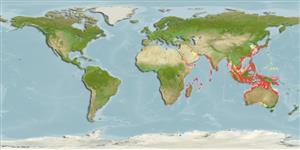分类 / Names
俗名 | 同种异名 | Catalog of Fishes(属, 种) | ITIS | CoL | WoRMS | Cloffa
Teleostei >
Eupercaria/misc (Various families in series Eupercaria) >
Sparidae (Porgies)
Etymology: Rhabdosargus: Greek, rhabdos = stick + Latin, sargus = sargus (1591) (Ref. 45335).
More on author: Forsskål.
Environment: milieu / climate zone / depth range / distribution range
生态学
海洋; 半咸淡水 礁区鱼类; 海洋洄游的 (Ref. 51243); 深度上下限 0 - 60 m (Ref. 30573). 熱帶; 36°N - 38°S, 19°E - 155°E (Ref. 57004)
Indo-West Pacific: Red Sea and East Africa to Japan, China, and Australia.
印度-西太平洋: 紅海而且東非到日本,中國與澳洲。
Length at first maturity / 大小 / 重量 / 年龄
Maturity: Lm 23.7 range ? - ? cm
Max length : 80.0 cm TL 雄鱼/尚未辨别雌雄; (Ref. 3678); common length : 45.0 cm TL 雄鱼/尚未辨别雌雄; (Ref. 1724); 最大体重: 12.0 kg (Ref. 1724)
背棘 (总数) : 11; 背的软条 (总数) : 12 - 13; 臀棘: 3; 臀鳍软条: 10 - 11. Bright yellow mark above the pelvic base.
在腹鳍基底上面的鲜黄色的标志。
Inhabit coastal waters (Ref. 30573, 44894), usually entering estuaries (Ref. 44894). Abundant in shallow water and often caught at the surf-line or in rock pools (Ref. 9987). Larger, solitary fish sometimes enter brackish mangrove areas (Ref. 9987). Juveniles in estuaries move into deeper water with growth (Ref. 4335). Often in schools (Ref. 9710). Feed on benthic invertebrates, mainly mollusks (Ref. 5213) and aquatic macrophytes (Ref. 26055). Popular angling species commonly captured with hook and line (Ref. 44894). Marketed fresh (Ref. 5284).
栖息于沿岸水域 (参考文献 30573,44894), 通常进入河口.(参考文献 44894) 丰富的在浅水区中而且时常捕获于碎浪区或在岩石区潮池中.(参考文献 9987) 比较大又独居性的鱼有时进入半咸淡的红树林区域。 (参考文献 9987) 河口的稚鱼随着成长移进较深的水域中。 (参考文献 4335) 常形成鱼群.(参考文献 9710) 吃底栖的无脊椎动物, 主要地软件动物 (参考文献 5213) 与水生的大型植物.(参考文献 26055) 受欢迎的钓鱼种通常用一支钓捕获了。 (参考文献44894) 在市場上銷售生鮮地了。 (參考文獻 5284)
Life cycle and mating behavior
成熟度 | 繁殖 | 产卵场 | 卵 | 孕卵数 | 仔鱼
Normally sexes are separate but some individuals are protandrous due to geographical variation in sexual pattern (Ref. 103751). Gonochorism is confirmed in Australia, and protandry in Asia (Ref. 103751). Also Ref. 28504.印度-西太平洋: 紅海而且東非到日本,中國與澳洲。
Bauchot, M.-L. and M.M. Smith, 1984. Sparidae. In W. Fischer and G. Bianchi (eds.) FAO species identification sheets for fishery purposes. Western Indian Ocean (Fishing Area 51). volume 4. [var. pag.] FAO, Rome. (Ref. 3507)
世界自然保护联盟红皮书 (Ref. 130435: Version 2024-1)
人类利用
渔业: 商业性; 养殖: 商业性; 游钓鱼种: 是的
工具
特别资料
下载 XML
网络资源
Estimates based on models
Preferred temperature (Ref.
123201): 21.9 - 29, mean 28 °C (based on 1662 cells).
Phylogenetic diversity index (Ref.
82804): PD
50 = 0.5156 [Uniqueness, from 0.5 = low to 2.0 = high].
Bayesian length-weight: a=0.01995 (0.01666 - 0.02389), b=2.96 (2.91 - 3.01), in cm total length, based on LWR estimates for this species (Ref.
93245).
营养阶层 (Ref.
69278): 3.3 ±0.47 se; based on food items.
Generation time: 3.3 ( na - na) years. Estimated as median ln(3)/K based on 1
growth studies.
回复力 (Ref.
120179): 中等的, 族群倍增时间最少 1.4 - 4.4年 (Assuming tm=2-4).
Fishing Vulnerability (Ref.
59153): Moderate vulnerability (36 of 100).
Climate Vulnerability (Ref.
125649): Very high vulnerability (88 of 100).
Nutrients (Ref.
124155): Calcium = 34 [15, 69] mg/100g; Iron = 0.537 [0.280, 1.105] mg/100g; Protein = 19.7 [18.4, 21.1] %; Omega3 = 0.114 [0.068, 0.201] g/100g; Selenium = 39.8 [20.0, 80.7] μg/100g; VitaminA = 26.9 [6.4, 109.3] μg/100g; Zinc = 0.956 [0.602, 1.420] mg/100g (wet weight);
